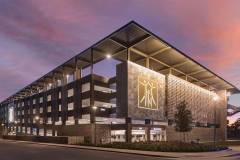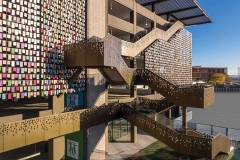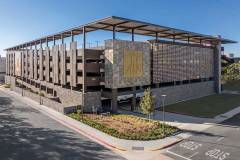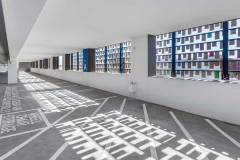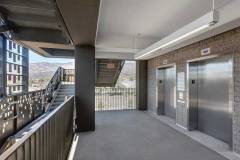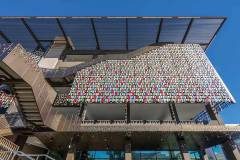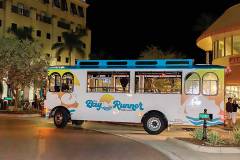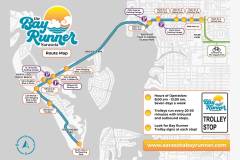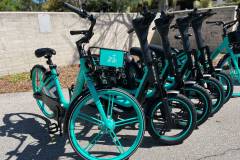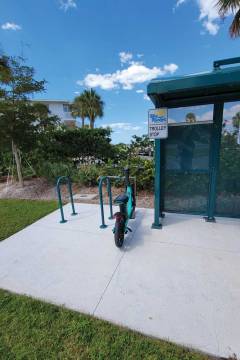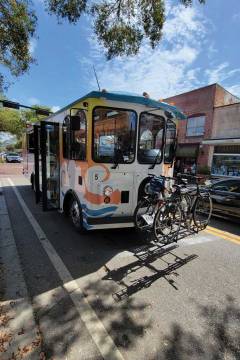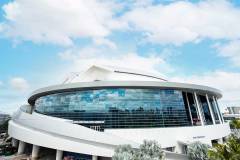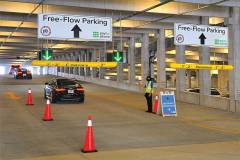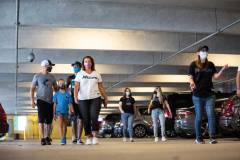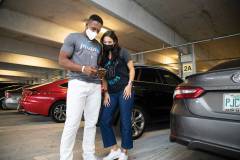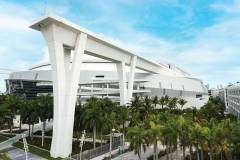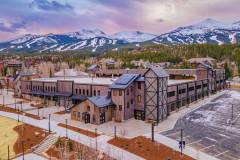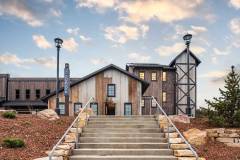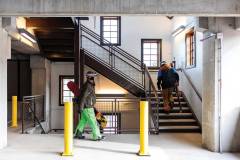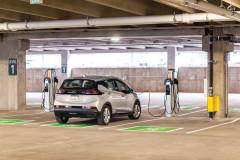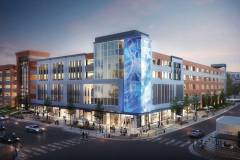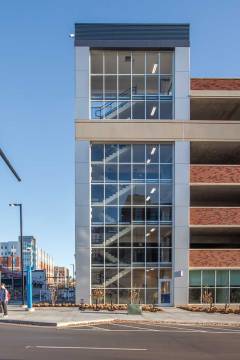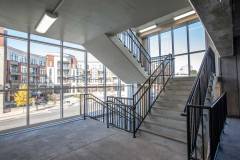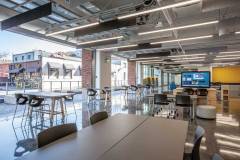Five stellar projects exemplify the best of the best in the 2022 IPMI Awards of Excellence program.
Setting the achievement bar ever higher in parking and mobility, these projects reflect the zeitgeist in their originality, creativity, and responsiveness to owner goals, user needs, and social and environmental context. A jury of seasoned industry professionals who recognize innovation in design and programming when they see it bestowed IPMI’s highest honor on outstanding examples of inspired solutions to a variety of challenges. We think you’ll agree. Here are the five projects that have been honored with a 2022 IPMI Award of Excellence.
This year’s winning projects are:
- City of Hope Parking Structure A, Architectural Design
- The Bay Runner Trolley and Micromobility Program, Innovation in a Mobility, Transportation or Parking Program
- Free Flow Parking at loanDepot, Innovation in a Mobility, Transportation or Parking Program
- South Gondola Lot Parking Structure, Stand-Alone Parking Facility Design
- University of Kentucky Cornerstone Mixed-Use Facility, Mixed-Use Parking & Mobility Facility Design
City of Hope Parking Structure A
Duarte, California
Architectural Design
- AWARDED TO: McCarthy Building Companies, Inc.
- OWNING AGENCY: City of Hope National Medical Center, Duarte, California
- DESIGN-BUILDER: McCarthy Building Companies, Inc.
- CONSTRUCTION MANAGER: Jacobs
- ARCHITECT: TRC Parkitects
- ARCHITECT (BRIDGING DOCUMENTS): CO Architects
Juror Comment
“The City of Hope Parking Structure A not only exceeded construction design features but also spent tremendous effort in planning features that will offer its users and patients of the adjacent medical center an uplifting and healing response.”
Photos courtesy of RMA Photography
Founded in 1913, City of Hope has become a world leader in the research and treatment of cancer and other serious diseases. In addition to more than 30 clinical network locations in southern California, their 116-acre main campus in Duarte, 21 miles northeast of Los Angeles, houses 1.6 million gross square feet of medical and support facilities.
With the adoption of the City of Hope Specific Plan in October 2018, the institution embarked on a 20-year expansion and enhancement initiative at the main campus that will add approximately 1 million square feet. The plan addresses the replacement of outdated buildings with modern facilities and provides guidelines for site planning, architectural design, landscaping, lighting, resource conservation, signage, and public art involving new construction.
Chapter 4, Mobility & Streetscape, covers the development of parking structures, surface parking lots, pedestrian amenities, and related improvements. Its guidelines for general parking structure design and parking space and drive aisle dimensions—in concert with the Plan’s overall design guidelines—provided the foundation for the design-build team to exercise their creativity.
Prominently located at the campus’s northeast corner on an 8.1-acre site entered from Duarte Road, the project created 987 spaces in the six-level parking structure and another 100 in a surface lot on its north side. Not only does the new facility simplify current access for patients, visitors, and staff to the adjacent Michael Amini Transfusion Medicine Center, it will also serve the Duarte Outpatient Clinic, an eight-story building scheduled for completion in 2024.
Since it opened in December 2021, the parking structure has been a welcoming gateway to the City of Hope. Its most striking feature is a vibrant, kinetic façade animating the north, west, and south elevations. The “tags,” which get their color from Kynar coating, reference the ribbons and tags that patients have traditionally tied to City of Hope cherry trees, carrying messages of thanks and wishes for cancer cures. This theme is further extended—via perforations—to the metal safety panels on the cantilevered open stairway that appears to float across the campus-facing façade.
Interior vertical circulation is provided by two elevator cores and stairways located at each end the campus-facing side of the structure, where they connect with pedestrian pathways at ground level. Each core has two elevators whose shafts are constructed with decorative masonry; cab interiors are outfitted with stainless steel textured wall panels, handrails, and call stations.
A user-friendly wayfinding system incorporates the owner’s logos at each of the three vehicle entries. Once inside, a dynamic parking space availability sign signals open spaces. This device, along with graphic signage, a color coding and numbering system, and enhanced lighting, is repeated on each level.
Other elements that combine to transform this utilitarian facility into a veritable work of art include gabion walls echoing the cobble wall of the adjacent river wash; thoughtful landscape and hardscape design; back-lit City of Hope logos; dramatic lighting illuminating the kinetic façade; continuous vertical lights on the two elevator cores; and lighted stair handrails. As darkness falls, the exterior lighting renders Parking Structure A into a glowing beacon visible from the nearby 605 freeway, guiding campus visitors to it unerringly.
The Bay Runner Trolley and Micromobility Program
Sarasota, Florida
Innovation in a Mobility, Transportation, or Parking Program
- AWARDED TO: City of Sarasota, Florida
- MARKETING AGENCY: Next-Mark Marketing
Juror Comment
“The motto of ‘Live more, drive less’ is perfectly put into practice with this experiential journey, provided by the City of Sarasota’s Bay Runner Trolley and Micromobility Program. Transporting employees, residents, and tourists between the beach and downtown in a stress-free, fun, and free manner, will have huge and lasting benefits to both riders and City alike.”
Photos courtesy of Next-Mark Advertising and Mark Lyons
Sarasota is located south of Tampa on Florida’s Gulf Coast. In keeping with its May 2022 U.S. News and World Report ranking as #9 in the nation’s “Best Places to Live,” and #1 as “Best Places to Retire,” it offers bountiful cultural and environmental amenities and serves as a gateway to miles of white sand beaches on barrier islands within the city limits.
As the seat of a county that draws close to three million visitors a year, and with a population approaching 60,000, Sarasota’s new Bay Runner trolley and micromobility programs provide sustainable solutions to mitigating traffic congestion. Their catalyst was “Sarasota in Motion,” adopted in July 2020 as the city’s first transportation master plan. During its development, citizen input helped crystallize community transportation needs and objectives for the next 25 years.
Launched to much fanfare on March 2, 2022, the free, open-air Bay Runner trolley manifests a key master plan priority: improving core route transit. Its purpose is to alleviate traffic between downtown Sarasota and the barrier islands by offering an easy, hassle-free alternative to driving for residents, visitors, and workers. The insightful project was realized through a partnership between the city, the Downtown Improvement District (DID), St. Armands Business Improvement District (BID), and the Florida Department of Transportation (FDOT). In addition to city economic development funds, and a $1.5 million FDOT grant, the DID and BID each allocated $50,000 toward the initial three-year program. The service is operated by CPR Medical Transport, the same company that runs the Siesta Key Breeze trolley.
The trolley service, which uses two vehicles emblazoned with a colorful logo, operates seven days a week from 8:00 until midnight, with 14 stops along the way between Lido Key, St. Armands Circle, and downtown. Each trolley seats a maximum of 28 and is equipped with two wheelchair positions and a lift. A downloadable app displays stop locations, where the closest trolley is, and when the next one will arrive.
Because Sarasota has a linear central business district, with a long bridge and causeway to shopping, dining and the beach, an accompanying scooter and bicycle micromobility program with 400 vehicles provides first mile-last mile mobility options and helps to lessen the need to park and then drive several blocks to another destination. The program is operated by Veo under a two-year contract with the city. The company’s app provides a map showing rental and parking locations and accepts payment at the end of use.
Launching both the Bay Runner and the micromobility program within days of each other took a tremendous degree of planning and field analysis. Strategy for identifying trolley stops and micromobility parking areas focused on finding locations where pedestrian accessibility was high but would not be adversely impacted by the new program features. Working together, these two programs benefit the community by connecting parks, roads, and services in an environmentally and user-friendly way.
The creative and clear “Live more, drive less” message applies to both programs. Print and TV advertising, a custom brochure, and strategic placement of rack card displays helped spread the word about the trolley, and the ringing of its bell at each stop signals its welcome presence.
Free Flow Parking at loanDepot
Miami, Florida
Innovation in a Mobility, Transportation, or Parking Program
- AWARDED TO: Miami Parking Authority
Juror Comment
“Free Flow Parking at loanDepot Park promotes innovative ways to manage the area known as ‘The Last Mile Challenge.’ The park now provides clients exactly what they desire: to get in and out with the least resistance possible. The Miami Parking Authority leaps forward with this initiative, showing the industry how to make this possible.”
Photos courtesy of the Miami Marlins
(*unless specified otherwise)
It is said that teamwork makes the dream work, and in this case, a partnership between the Miami Marlins and the Miami Parking Authority (MPA) inspired a novel solution to a consistent problem on game day. As the first venue of its kind in the United States to implement a free flow parking program, this Major League Baseball stadium stands as an exemplar to other such venues with similar issues.
LoanDepot Park is located on 17 acres in Miami’s Little Havana neighborhood. It is surrounded by narrow streets, major highways, and one of the busiest east-west arteries in the city. Local traffic gridlock on game day had long been a point of contention for the community and fans, who endured a wait of 45 to 120 minutes to travel the final mile to a parking spot. This is such a widespread phenomenon among urban critical-mass venues that it has a name: the last mile challenge.
In response to customer and community concerns, the Miami Marlins and MPA teamed up to survey and study the parking dynamics. Research revealed that the main point of friction was the cashiering process. The procedure, which involved attendants collecting payment at the entrance, took an average of 28 to 40 seconds to move a three-car queue. With a stadium parking capacity of over 5,600 spaces, backups became as inevitable as they were untenable.
In contrast, free flow parking allows attendees to enter the garage without stopping to scan a pass or show credentials for payment collection. Now, vehicles drive straight to one of four garages or six surface lots and proceed to an available parking spot. With this frictionless parking system, vehicles are automatically identified by license plate recognition technology when entering or exiting the facilities. Each garage is equipped with five cameras, and two mobile enforcement vehicles each have two cameras.
How does it work? Event-goers with a parking pass register their vehicle’s license plate ahead of or upon arrival via ParkWhiz. All others register their license plate and pay on site using the PayByPhone app or Flowbird pay stations located in garage lobbies. Vehicles are then validated during the event based on the registration status of their license plate.
Payment vendors are synchronized with the Genetec pay-by-plate sync engine to update in real time vehicles that have paid for parking. This information is communicated to the enforcement vehicles to identify violators passing through the garages during the game. An enforcement tour of the parking facilities halfway through the event identifies vehicles with unpaid parking sessions.
The game-changing free flow parking system has enhanced traffic flow and mobility around loanDepot Park; decreased peak season in-traffic time in the last mile by 75%; cut time to find a parking spot by half; and largely eliminated community concerns. Additionally, free flow parking has yielded an annual operational expense savings of approximately $304,000 and increased fan patronage of stores and concessions because they now have more time and energy to do so.
South Gondola Lot Parking Structure
Breckenridge, Colorado
Stand-Alone Structured Parking Facility Design
- AWARDED TO: Walker Consultants
- OWNING AGENCY: Town of Breckenridge, Colorado
- ENGINEER: Walker Consultants
- ARCHITECT: Koch Covotsos Architects
- GENERAL CONTRACTOR: Hyder Construction
Juror Comment
“The South Gondola garage is a great example of how to combine natural design elements within a community, along with sustainable features that will make this award winner shine for years to come.”
Photos courtesy of The Unfound Door
The past, present, and future coalesce sublimely in this distinctive facility situated on 6.43 acres just off of Main Street in the Breckenridge National Historic District. Set against a stunning backdrop of the picturesque Rocky Mountains’ Tenmile Range, the new South Gondola lot parking structure has been a major boon to improved traffic circulation in this ski destination that attracts tourists year-round. Although its permanent population is less than 5,000, Breckenridge attracts close to three million visitors a year. That’s a lot of cars, and convenient, ample parking is critical to serving resident and visitor needs.
The story began in 2017, when a parking structure was being considered for a town-owned lot but did not move forward because the location was not as appealing as the South Gondola lot, which is owned by Vail Resorts. In spring 2019 Town Council selected the team led by Walker Consultants to design the new parking structure for that site and passed an ordinance that allowed the town to enter into a 50-year ground lease with the owner to use the property for the $38.25 million facility, which comprises structured and surface parking.
The design program was developed in response to multiple goals, including capacity, functionality, sustainability, aesthetics, and user amenities—and the South Gondola lot parking structure has achieved them all. Aiming to decrease local traffic and accommodate drivers seeking parking during peak ski season, the public facility provides 716 parking spaces within a four-level, 249,984-square-foot structure and 243 spaces on the surface lot, adding 412 spaces beyond the surface lot’s previous capacity.
Functionality is reflected in various ways through the structure’s design and construction, which incorporated precast concrete with a cast-in-place topping slab supported through a spread footing foundation system. The mountain environment and remote location factored into selecting a precast structural system due to the shortened construction season for concrete placement.
Among the key functional elements are a three-bay fat slab with end bay express D-ramp circulation; passive security measures; interior and exterior wayfinding signage; two oversized high-speed machine room-less traction elevators; a hydronic snow melt system on exposed slabs, outdoor plaza, and pathways; and integrated license plate recognition parking management with space availability and pay-on-foot kiosks.
On the sustainability, future-forward side, the project incorporates 22 electric vehicle charging stations and electrical capacity for 38 additional stations; LED light fixtures; electric bike corrals; and photovoltaic solar panels on the south and west roofs. To further enhance the user experience, the design features robust landscaping; a pedestrian plaza on the east side that extends south, providing a breezeway connection to the Blue River Trail; pedestrian connectivity to the town core; and a 22-stall restroom facility.
Aesthetically, the architectural façade of the parking structure was inspired by Breckenridge’s history as a mining town in the late 19th century and the natural beauty of the surrounding mountains. The elevator stair towers, vehicular ramp, and outbuildings employ the use of timber trusses over corten rusted steel siding, evoking mining structures. The thoughtful integration of historic elements was instrumental in obtaining Landmark Preservation approvals.
University of Kentucky Cornerstone Mixed-Use Facility
Lexington, Kentucky
Mixed-Use Parking & Mobility Facility Design
- AWARDED TO: THA Consulting, Inc.
- OWNER: University of Kentucky
- PARKING CONSULTANT: THA Consulting, Inc.
- ARCHITECT: Sherman Carter Barnhart Architects
- DEVELOPER: Signet Real Estate Group
Juror Comment
“The University of Kentucky Cornerstone Mixed-Use Facility has developed a special place that enhances local community engagement, especially between the university and the downtown. Opening this mixed-use facility to unique amenities such as a gaming center and shared office space, brings a new approach to parking garage developments by helping promote the best in societal diversity.”
Photos courtesy of Chris Phebus Architect + Photographer
(*unless otherwise specified)
Designed as a hub of activity around innovation, entrepreneurship, and economic development, The Cornerstone was achieved through a public-private partnership between Signet Real Estate Group and the University of Kentucky (UK). Combining four levels of parking for 935 cars above 23,000 square feet of mixed-use ground floor space, the facility marks a critical milestone in UK’s transportation master plan.
The P3 project was realized through establishment of a lease-leaseback model. Stakeholders created a limited liability corporation to ground-lease the property to Signet, which is leasing the parking deck back to the LLC for 30 years. When the lease obligation is fulfilled, the parking facility will revert back to the university. Responsibilities and oversight for discrete portions of the structure are clearcut: Signet oversees the leasing, tenant relations, and management of ground floor retail components, and UK manages the parking facility and dedicated community spaces.
Two primary goals informed the project’s program and design: creation of a stimulating destination for students that also increased UK’s parking capacity; and establishment of a gateway to an emerging innovation district that will further link the university with the city of Lexington. Another goal was to activate the streetscape surrounding the facility. Thoughtful site planning created a pedestrian-friendly setback with room for outdoor seating, and streets were widened to incorporate bike lanes. A significant commitment was made to public art. Not only did this result in numerous unique artworks throughout the facility, but it also inspired a campus-wide transformation.
The four components of the 308,269-square-foot structure are parking, retail, innovation space, and an esports lounge and theater. The new parking facility was designed to connect with an existing UK garage via vehicular bridges at each level, bringing the total number of spaces to more than 2,300. To reduce search time and help with wayfinding, a guidance system at the entry point of each level indicates the number of available spaces.
Embracing the spirit of the university while considering neighborhood context, the building façade blends traditional elements of the historic campus with the more modern, urban vibe of the city’s downtown. There’s a touch of Times Square too, with a dazzling 55-foot-tall exterior PixelFLEX media wall that manifests the university’s smart-campus efforts and serves as a digital billboard for relevant messaging. Its versatile LED lighting can be programmed to match other campus buildings.
A glass curtain wall characterizes the significant mixed-use component at street level and visually merges campus and community. The Cornerstone Exchange—the retail component—features a large food hall with a coffee shop, a brewery, and restaurants, all owned by local entrepreneurs. The flexible innovation space features cutting-edge technology in an expansive open format and garage-style doors that can be rolled up when weather permits, letting the outside in. The UK Federal Credit Union Esports Lounge was designed for students and community members to experience gaming on high-end machines and consoles in an energetic yet comfortable environment. It offers more than 50 PC-based units and multiple console play areas. With 100 seats on retractable risers, the esports theater is adaptable to a variety of uses.
To read about more 2022 IPMI Award winners, check out IPMI 2022 Awards of Merit.
Dorothy J. Verdon, CPSM is Owner of Bright Bunny Communications.








